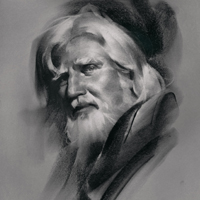Begin a serious exploration of drawing the portrait from life in charcoal with Nathan Fowkes. Follow step …
$399.00
Course Access
Unlimited Duration
Total Video Time
10 hours, 8 minutes
Begin a serious exploration of drawing the portrait from life in charcoal with Nathan Fowkes. Follow step by step through the practical stages of emphasizing the structure and planes of the head, clearly rendering the values of light and shadow, designing edges and creating likeness and composition. Explore numerous drawing techniques, materials and approaches
BIO: Nathan Fowkes is a veteran entertainment and fine artist. He has taught traditional and design courses for over a decade. Nathan was a conceptual artist for top animated films with notable clients such as DreamWorks, Disney and Blue Sky. He has worked on 11 feature films including: The Prince of Egypt, Spirit, Shrek Universe, How to Train Your Dragon and The Legend of Puss in Boots. He is also a consultant for clients that include: Blizzard Entertainment, Infinity Ward, Disney Interactive, Riot Games, Ubisoft and Rovio. Nathan is currently a design lead at Paramount Feature Animation.
Nathan Fowkes
About Instructor
Nathan Fowkes is a veteran entertainment and fine artist. He has taught traditional and design courses for over a decade. Nathan was a conceptual artist for top animated films with notable clients such as DreamWorks, Disney and Blue Sky. He has worked on 11 feature films including: The Prince of Egypt, Spirit, Shrek Universe, How to Train Your Dragon and The Legend of Puss in Boots. He is also a consultant for clients that include: Blizzard Entertainment, Infinity Ward, Disney Interactive, Riot Games, Ubisoft and Rovio. Nathan is currently a design lead at Paramount Feature Animation.
Course Curriculum
-
- Portrait Drawing in Charcoal | Preview FREE 00:05:00
- Preview for Portrait Drawing in Charcoal with Nathan Fowkes
-
- Drawing the Portrait in Charcoal | Introduction 00:36:00
- This class will put you squarely on the path toward creating successful portrait drawings in charcoal. Nathan will introduce the class, and take you through the process of understanding the planes and three dimensional nature of the head to create a sense of life on a two dimensional page.
- Construction Drawing 00:31:00
- Every line and tone must be designed to describe form. The Reilly head abstraction is a tool that can be used to help guide the placement of lines and tones. Each week the homework assignment will be to bring at least one finished portrait. The first homework assignment is to make a line drawing of a portrait using the appropriate Reilly abstraction lines.
- Construction Drawing Demo FREE 00:38:00
- Demonstrations will explain how to break down the complexities of the head to achieve simple and clear statements. Drawing concave lines or lines that go against the forms can hurt the dimensionality of the drawing. Wrapping lines around forms will help achieve volume and depth in your drawings.
- Laying down the foundation 00:10:00
- Last weeks lecture on foundational drawing is reviewed. The homework assignment is the same as last week, to make a construction drawing showing the three dimensional quality of the head. Working methods will be discussed to help guide inexperienced students.
- Drawing the Portrait in Charcoal | Demonstration 1 00:25:00
- This demo will focus on the simplest way to quickly establish the three dimensional quality of the structure of a female model. Carefully wrap the longitudinal and latitudinal lines around the figure to get a sense of form. How to use the Reilly abstraction as a tool and not a formula.
- Rendering the Shadow 00:22:00
- Squinting will help reveal the simple value relationships between light and shadow. Students should practice squinting and comparing in order to emphasize the three dimensional statement.
- Clarity of Form in the Shadows 00:23:00
- A simple process will give clarity to your portraits, through turning form with shadows. Examples will be presented on how to maintain the value statement. Similar to last week, the homework assignment will be to focus on rendering form in the shadow leaving the light side white.
- Designing with Edges 00:42:00
- The design of edges can have a profound impact on the clarity and depth of your portrait. Selective use of edges can add emphasis to a subject, or they can be lost entirely for dramatic purposes. The homework is to design edges for a full value portrait with a single light source.
- Edges Demonstration 00:23:00
- Use edges to create both a sense of depth and artistic emphasis in your drawing.
- Building a Likeness 00:42:00
- How to find the likeness and character of your subject without getting lost in the nuances of anatomy. We’ll also take a look at alternate materials and techniques including chalks on toned paper. The homework is to use Strathmore charcoal Paper 500 series "storm gray" for a portrait with a subject in direct light.
- Portrait on Toned Paper with White Chalk 00:37:00
- The homework assignment will be demonstrated using the gray paper as the half tone. The dark charcoal will expand the value range in the shadows; the white chalk will expand the value range in the light.
- Costumed Portrait on Green Paper 00:12:00
- A portrait of a costumed model directly lit will be done on green toned paper.



